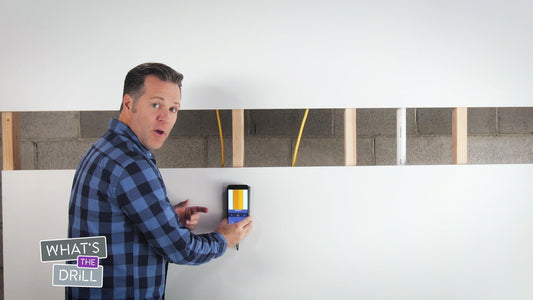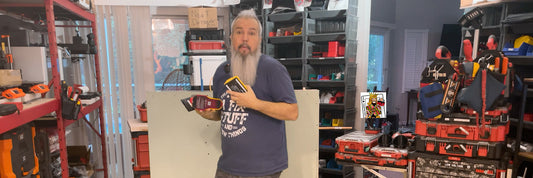Embarking on a DIY project in your home? Before you drill that first hole into your drywall, understanding what's hidden behind it is paramount – a task made significantly easier and safer with modern wall imaging devices, including advanced systems like Walabot. Ignorance of studs, pipes, or wiring within your drywall construction can lead to costly damage, dangerous situations, and project failure. This is where wall detection devices become indispensable. This guide will navigate you through the diverse world of these tools, helping you select the perfect one for your drywall-focused DIY ambitions, with a special focus on advanced solutions like Walabot.
Why Look Inside Your Drywall?
Before you even think about picking up a drill or saw for your drywall project, understanding the hidden landscape within your walls is crucial. These devices help you "see" or detect:
- Structural Elements: Wooden or metal studs that form the framework of your drywall walls.
- Utilities: Electrical wiring, plumbing pipes (both metal and plastic), and HVAC ducting.
- Obstructions: Unexpected blockages or noggins behind the drywall.
Knowing the precise location of these elements is key to avoiding hazardous mistakes (like hitting a live wire or a water pipe within your drywall cavities) and ensuring your installations (shelves, TVs, cabinets) are securely anchored to studs.

A Spectrum of Wall Inspection Tools for Drywall: From Simple to Sophisticated
The market offers a range of devices, each with its strengths and ideal use cases, particularly for drywall applications. Let's explore them in an order that generally reflects increasing complexity and capability:
1. Magnetic Stud Finders:
-
- How they work: These basic tools use a small, powerful magnet to detect the metal screws or nails used to attach drywall to studs. Magnetic stud finders and magnets can also detect metal studs.
- Best for: Finding the approximate location of studs in drywall where metal fasteners are present. Very budget-friendly for simple drywall tasks.
- Limitations: Won't find pipes or wires directly, only metal fasteners. Less precise for stud edges. Magnetic stud finders and magnets also frequently miss screws or nails. The accuracy of stud detection also depends on the quality of the drywall installation. If the installers missed the center of the stud or missed the stud entirely – that’s what you will pick up.
2. Electronic Stud Finders (Capacitance-Based):
-
-
How they work: These devices detect changes in the dielectric constant (density) of the wall. As you slide them across the drywall, they identify the denser areas where studs are located.
- Edge Finders: Indicate the edges of a stud.
- Center-Finding: Pinpoint the center of the stud, often more convenient for drywall mounting.
- Best for: General stud finding in drywall. Many models also include basic AC wire detection (live, unshielded wires near the drywall surface).
- Limitations: Can be fooled by irregularities in drywall density or texture. Metal stud detection can be hit-or-miss with basic models. AC detection is often limited to wires close to the drywall surface. Pipes and non-live wires are not detected.
-
How they work: These devices detect changes in the dielectric constant (density) of the wall. As you slide them across the drywall, they identify the denser areas where studs are located.
3. Borescopes (Inspection Cameras):
-
- How they work: A small camera on a flexible or semi-rigid cable connects to a handheld screen or smartphone. You drill a small hole in the drywall and insert the camera to visually inspect the cavity behind it.
- Best for: Detailed visual inspection of a known void or problem area within a drywall cavity. Can be used for diagnosing leaks, checking for pests, tracing wires or pipes if accessible.
- Limitations: Requires drilling an initial hole in the drywall, which may not always be desirable. Only shows what the camera can physically reach and see; can be limited by vertical studs and horizontal fire stops.
4. Thermal Imagers:
-
- How they work: These devices detect differences in surface temperature on the drywall and display them as a heat map.
- Best for: Identifying insulation gaps behind drywall, locating active water leaks (due to evaporative cooling or temperature difference of water affecting the drywall surface), finding overloaded electrical circuits (which generate heat), or even locating studs if there's a significant temperature difference between the stud and the drywall cavity.
-
Limitations:
- Doesn't "see" objects directly but infers their presence through temperature differences on the drywall surface. Interpretation can require some experience.
- Won't detect non-active wires or pipes at the same temperature as their surroundings.
- Even when objects like studs are detected, thermal imagers typically only trace very raw outlines on the drywall. They do not provide exact information about the object's shape or precise dimensions. This means that while a thermal imager might correctly indicate the presence and general location of a stud behind drywall, you cannot reliably use it to find the precise center needed for secure drilling and installation.
5. Advanced Wall Scanners (e.g., Radar-Based Imagers like Walabot):
-
- How they work: These devices utilize advanced technologies, often radio frequency (RF) or radar, to penetrate drywall and provide a visual representation of what's inside, often differentiating between material types.
- Best for: Comprehensive, multi-material detection within drywall. Ideal for users who need to reliably identify and map out studs (wood and metal), pipes (metal and plastic), and wiring behind drywall. Offers a much clearer picture than traditional stud finders.
- Limitations: Can be more expensive than basic tools, though the value offered often justifies the cost for serious DIYers working extensively with drywall. Professional-grade RF scanners can be significantly more expensive.
Key Factors to Consider When Selecting Your Device for Drywall
Regardless of the type, evaluate these aspects for your drywall projects:
- Detection Capabilities: What exactly do you need to find behind your drywall? Studs only? Pipes? Wires (live or not)? Plastic or metal? Ensure the device specifications match your most common needs for drywall construction.
- Depth of Detection: Most devices will suffice for standard single-layer drywall. However, if you’re working with double-layered drywall, thicker drywall constructions, or need to detect objects further back in the wall cavity, look for a device that offers deeper detection capabilities through these materials.
- Material Differentiation: Can the device distinguish between a metal stud, a copper pipe, and electrical wiring behind the drywall? This is a crucial feature for avoiding misidentification and potential hazards.
- Display and User Interface: Clarity is key. Options range from simple LEDs and audio cues to basic graphical LCD screens and visual smartphone app interfaces that provide a visual and intuitive map of what's behind the drywall.
- Accuracy and Reliability: This is non-negotiable. A device that gives false positives or misses critical items in your drywall is worse than no device at all. Check reviews and brand reputation.
- Ease of Use and Ergonomics: A comfortable, easy-to-maneuver device will make your job simpler, especially on larger drywall projects.
- Drywall Compatibility: Confirm the device is optimized for standard drywall. Some devices might struggle with textured drywall surfaces, wallpaper, or the presence of certain types of insulation (like foil-backed insulation) within the wall cavities, which can interfere with detection accuracy.
- Additional Features: Some units offer built-in levels, rulers, or connectivity options (Bluetooth/Wi-Fi) to transfer data or enhance functionality with apps.
- Budget: Prices vary widely. Set a realistic budget, but be prepared to invest reasonably for greater accuracy, versatility, and durability, especially if you plan on frequent or complex DIY work on drywall.
Walabot: The DIY Game-Changer for Drywall Imaging
When it comes to versatility and precision for the serious DIYer working with drywall, Walabot devices stand out as a leading choice in the advanced wall scanner category. They leverage hi-tech RF technology to provide a true window into your drywall, displayed conveniently on your smartphone screen.
Essential Features that Make Walabot a Winner for Drywall Projects:
- Multi-Material Detection: Walabot devices can identify and differentiate between wooden studs, metal studs, metal pipes, plastic pipes, live and non-live wires, and even data cables within drywall walls.
- Deep Penetration for Drywall and Other Common Sheathing: Capable of seeing effectively through standard drywall, plywood, and OSB, and can handle variations or multiple layers depending on the specific Walabot model.
- Visual Mapping: Instead of just beeps or lights, Walabot provides a graphical representation of objects behind the drywall on your Android or iOS smartphone (compatibility varies by Walabot model). You see a visual layout, making it easier to understand the position and type of hidden elements.
-
Multiple Scanning Modes (Model Dependent):
- Images Mode: Visual and intuitive representation of wall interior. Detects and visualizes wood studs, metal studs, as well as Wires/Pipes
- Expert Mode: Offers a raw, unprocessed view of the signals from behind the drywall, allowing experienced users to analyze complex structures and even detect movement, like pests.
- Adjustable Sensitivity & Calibration: Allows you to fine-tune the device for different drywall setups, improving accuracy, accessible in the Expert Mode.
- Locates Stud Centers and Edges: Provides comprehensive information for secure mounting into studs behind drywall.
- Tracks Paths of Pipes and Wires: Helps you understand the trajectory of utilities within your drywall walls.
- Cost-Effective for DIYers and Professionals: Offers multi-material detection capabilities relevant to DIY needs at a more accessible price point compared to professional-grade RF wall scanners, while still providing robust functionality.
- User-Friendly App Interface: Designed to be intuitive, with tutorials and guides to help you get the most out of the device for your drywall projects.
While traditional stud finders have their place for simple tasks on drywall, and specialized tools like borescopes and thermal imagers excel in niche applications, Walabot offers a comprehensive, all-in-one solution that significantly reduces guesswork and enhances safety for a wide array of DIY projects involving drywall. Its ability to not just detect, but to visualize and differentiate multiple types of objects, truly sets it apart.
Walabot’s Suggestions Tailored to Your Drywall Needs:
Choosing the right Walabot can maximize your DIY success with drywall:
- I am a beginner and rarely do DIY projects, or I need a reliable, easy-to-use stud finder with enhanced capabilities for drywall: Consider the Walabot DIY 2 M. It offers excellent visual detection for studs, pipes, and wires behind drywall, making it a significant step up from traditional stud finders and perfect for common home projects.
- I do DIY projects all the time, tackle complex renovations involving drywall, or need the most comprehensive view into my walls: The Walabot DIY 2 Premium Bundle (or equivalent higher-tier models) is likely your best investment. These often include additional features or enhanced capabilities for seeing through drywall and providing more detailed imaging.
Conclusion
Successfully navigating the hidden world within your drywall is a cornerstone of safe and effective DIY. By understanding the different types of detection and imaging tools available—from basic magnetic finders to advanced radar scanners like Walabot—you can choose the device that best fits your project's complexity, your budget, and your desired level of precision for drywall applications. Investing in a quality wall imaging device isn't just about convenience; it's about safety, accuracy, and the overall success of your home improvement endeavors. With a tool like Walabot, you gain the confidence to drill, cut, and renovate your drywall, knowing exactly what lies beneath the surface.




